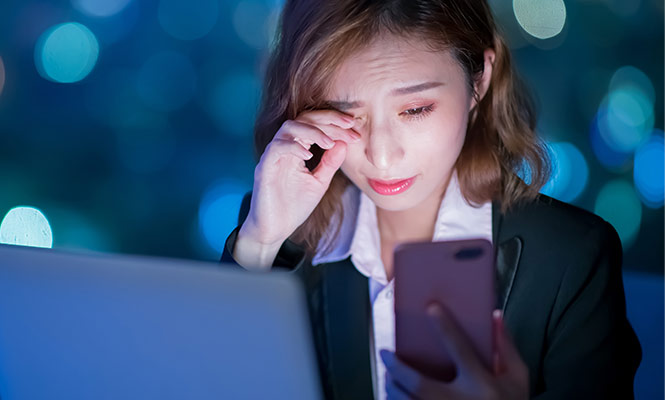In today's digital age, where screens are an integral part of our daily lives, eye strain has become a common problem for many people. Extended periods of screen time can lead to eye discomfort, dryness, blurred vision, and fatigue.
Eyestrain, also known as asthenopia, is a common condition characterized by discomfort, fatigue, and irritation in the eyes. It is often associated with extended periods of activities that require intense visual focus, such as reading, computer use, or prolonged exposure to screens
What Causes Eye Strain:

Understanding the causes of eyestrain can help us take preventive measures and reduce its impact on our eyes.
1. Prolonged Screen Time: The excessive use of digital devices is a leading cause of eyestrain. Staring at screens for extended periods without breaks can strain the eyes due to the high visual demand, the need for continuous focus, and the exposure to blue light emitted by electronic displays.
2. Poor Lighting Conditions: Insufficient or excessive lighting can contribute to eyestrain. Working in dimly lit environments forces the eyes to strain to see clearly, while overly bright lighting causes glare and discomfort. Both situations can lead to eye fatigue and strain.
3. Improper Viewing Distance and Angle: Viewing screens or reading materials at inappropriate distances or angles can strain the eyes. Sitting too close to the screen or holding reading materials too far or too close can force the eyes to work harder to focus, leading to fatigue and strain.
4. Uncorrected Vision Problems: Refractive errors, such as nearsightedness, farsightedness, or astigmatism, can strain the eyes when they are not properly corrected. Uncorrected vision problems can cause the eye muscles to work harder to compensate, leading to eyestrain. A lot of people do not realize their eyesight is getting worse over time. Regular eye tests once a year can keep this in check.
5. Lack of Blinking: When focusing intently on screens or other close-up tasks, people tend to blink less frequently. Reduced blinking leads to dry eyes, as tears evaporate more quickly, resulting in discomfort and eye strain.
6. Blue Light Exposure: The blue light emitted by digital screens can cause eyestrain. Prolonged exposure to blue light has been linked to disruptions in sleep patterns, eye fatigue, and potential long-term effects on retinal health.
7. Eye Muscle Fatigue: Sustained focusing on near objects, such as screens or books, can cause the eye muscles to become fatigued. The constant contraction of these muscles can lead to discomfort, strain, and even headaches.
8. Environmental Factors: Other environmental factors, such as dry air, dust, or allergens, can contribute to eye strain. Dry air can cause dryness and irritation, while allergens can trigger allergic reactions, leading to redness, itching, and eye fatigue.
9. Stress and Fatigue: Psychological factors like stress, anxiety, and fatigue can exacerbate eyestrain symptoms. When the body is under stress or experiencing fatigue, it can affect overall eye comfort and make the eyes more susceptible to strain.
How to Reduce Eye Strain

However, there are several practical measures we can take to alleviate eye strain and maintain healthy vision. This article will explore a range of effective strategies that can help relieve eye strain and promote optimal eye health.
1. Take Frequent Breaks: One of the simplest and most effective ways to alleviate eye strain is to take regular breaks from screen activities. Following the 20-20-20 rule can be highly beneficial: every 20 minutes, shift your gaze to an object at least 20 feet away for at least 20 seconds. This technique reduces the constant strain on your eyes by allowing them to focus on different distances, relax, and rehydrate. Set reminders or use apps that notify you to take breaks, ensuring that you don't neglect this important practice.
2. Blink Regularly and Moisturize: Staring at screens often leads to reduced blinking, causing dry eyes and discomfort. Be mindful of blinking consciously and frequently while working on digital devices. Additionally, using artificial tears or lubricating eye drops can help maintain adequate moisture and relieve dryness. These drops are readily available over the counter and provide temporary relief. However, it is advisable to consult with an eye care professional for personalized recommendations based on your specific needs.
3. Adjust Display Settings: Optimizing the display settings on your devices can significantly reduce eye strain. Begin by adjusting the brightness of your screen to match the ambient lighting. Excessive brightness can cause glare, while insufficient brightness strains the eyes. Moreover, adjusting the text size, contrast, and color temperature can make a noticeable difference. Warm color tones, such as those with reduced blue light emission, are easier on the eyes. Various software applications and browser extensions are available to reduce blue light emission, making it easier to work for extended periods without straining your eyes.
4. Maintain Proper Lighting: The lighting conditions in your environment play a crucial role in eye strain. Avoid working in overly bright or dimly lit areas, as both extremes can cause discomfort. Optimal lighting involves a balanced combination of ambient and task lighting. Ensure that the light source is not directly behind or in front of your screen, as it can cause glare or strain. Use curtains, blinds, or adjustable lighting fixtures to control the intensity and direction of light. Natural lighting is preferred, when possible, as it is gentler on the eyes compared to harsh artificial lighting.
5. Practice Eye Exercises and Massage: Performing simple eye exercises and massages can help relieve eye strain and improve blood circulation to the eyes. Some effective exercises include palming, where you rub your hands together to create warmth and gently place them over your closed eyes, and eye rolls, where you roll your eyes clockwise and counterclockwise. Additionally, massaging the temples and the area around the eyes with your fingertips in circular motions can alleviate tension. Regular practice of these exercises can enhance flexibility and relaxation in the eye muscles, reducing strain and promoting overall eye health.
6. Wear prescription eyeglasses: Eye strain might creep up on us without our knowledge. As the eyes strain more and more to see due to vision problems it might lead to further issues. With an eye test and the right prescription getting eyeglasses will help reduce eyestrain drastically. Whether full-frame eyeglasses or rimless eyeglasses there is one for everyone that suits your preference.
If you are looking for eyeglasses, be it for computer blue light protection, UV protection, power correction, or just plain aesthetics, EyeMyEye is the online platform for you! With a wide range of styles, colors, shapes, and materials, pick a frame and lens on the site easily. Avail massive discounts and more only on EyeMyEye.com.
Conclusion
Eye strain is a prevalent issue in our technology-driven lives, but it doesn't have to be an unavoidable consequence of screen use. By implementing the strategies discussed above, we can alleviate eye strain, maintain healthy vision, and prevent potential long-term complications. Remember to take regular breaks, blink frequently, optimize display settings, ensure proper lighting, and engage in eye exercises and massages.
To prevent and alleviate eyestrain, it is essential to take regular breaks, maintain proper lighting conditions, optimize screen settings, use appropriate eyewear if needed, practice good posture, and incorporate eye relaxation exercises into daily routines. Additionally, seeking regular eye examinations from an optometrist can ensure any underlying vision problems are addressed and managed appropriately.